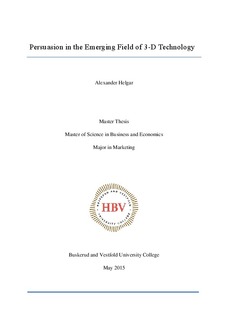| dc.description.abstract | This study examines the role of 3-D product visualization logos in marketing. Differences between 2-D and 3-D product visualization logos were tested in the areas of affective and behavioral components of attitudes. This relationship was later tested for the moderating effects of brand personality and level of involvement.
Previous research has identified different types of 3-D technology, and has explored the consumer reactions to stereographic 3-D imaging (Holbrook, 1998), 3-D product visualization (Lee, Li, and Edwards, 2012), stereoscopic 3-D (Yim, Cicchirillo, and Dumwright, 2012), and autostereoscopic 3-D technology (Dodgson, 2005). A combination of these 3-D technologies will be applied to my research to create and test a 3-D logo. I have synthesized Aaker’s 42-item Brand Personality Scale (1997), and evaluated the dimension of ‘excitement’ to see if the 3-D logo will be identified as more exciting than the normal 2-D logo. The Elaboration Likelihood Model is also used, and is considered a reliable resource in the field of persuasion due to its description of the central and peripheral routes of attitude change (Petty and Cacioppo, 1981). I have also considered the cognitive, affective, and behavioral components of attitudes, which have been validated and tested by Breckler (1984), when designing my study.
A casual research design guided the study and a laboratory experiment was conducted to test my hypotheses. The sample of N = 190 consists of young adults from the state of Texas in the United States of America. A 7-point Likert-scale was used to measure the affective and behavioral components of the experiment.
Key findings from the research illustrate that 3-D product visualization logos have an overall more positive effect on a subject than 2-D logos. The logos I tested were positively identified as ‘exciting’ in terms of brand personality, however, no differences were found in the level of excitement between the 2-D and 3-D logos. Additionally both involvement groups found the 3-D logo to be appealing, but the low involvement group found the 3-D logo to be even more appealing than the high involvement group in the area of affective measurement. Similarly, both involvement groups found the logo to be memorable and were interested to find out more about the brand, but there was no difference between the high and low involvement groups in the area of behavioral measurement. These findings could provide valuable implications to the field of logo branding, and this study has demonstrated the potential advantage to a 3-D product visualization logo in the field of marketing. | nb_NO |
